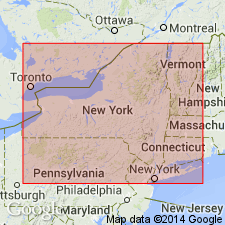
- Usage in publication:
-
- Alfred shale
- Modifications:
-
- Original reference
- Dominant lithology:
-
- Shale
Summary:
Pg. 263-264. Alfred shale. At Alfred Station, New York, consists of 2 beds: a layer of shale, about 5 feet thick, very fine-grained, containing a large and diverse fauna of "Chemung" age, overlain by 40 feet of barren siliceous shale, formerly used by nearby ceramic plants. Alfred shale is overlain by 6 feet of heavy calcareous sandstone, which G.H. Chadwick (personal commun.) considers to be top of Rushford sandstone of Canadaway group. Search was made at outcrops where the sandstone and shale should have been found, but all attempts to trace these beds there [into Rushford sandstones?] have been unsuccessful. Possibly these rocks have changed in their lithological and paleontological characters or are only lentils have not wide distribution. The fauna is limited to about 6 inches of the lower fine-grained shale. Age is Late Devonian.
Source: US geologic names lexicon (USGS Bull. 896, p. 30).
For more information, please contact Nancy Stamm, Geologic Names Committee Secretary.
Asterisk (*) indicates published by U.S. Geological Survey authors.
"No current usage" (†) implies that a name has been abandoned or has fallen into disuse. Former usage and, if known, replacement name given in parentheses ( ).
Slash (/) indicates name conflicts with nomenclatural guidelines (CSN, 1933; ACSN, 1961, 1970; NACSN, 1983, 2005, 2021). May be explained within brackets ([ ]).

